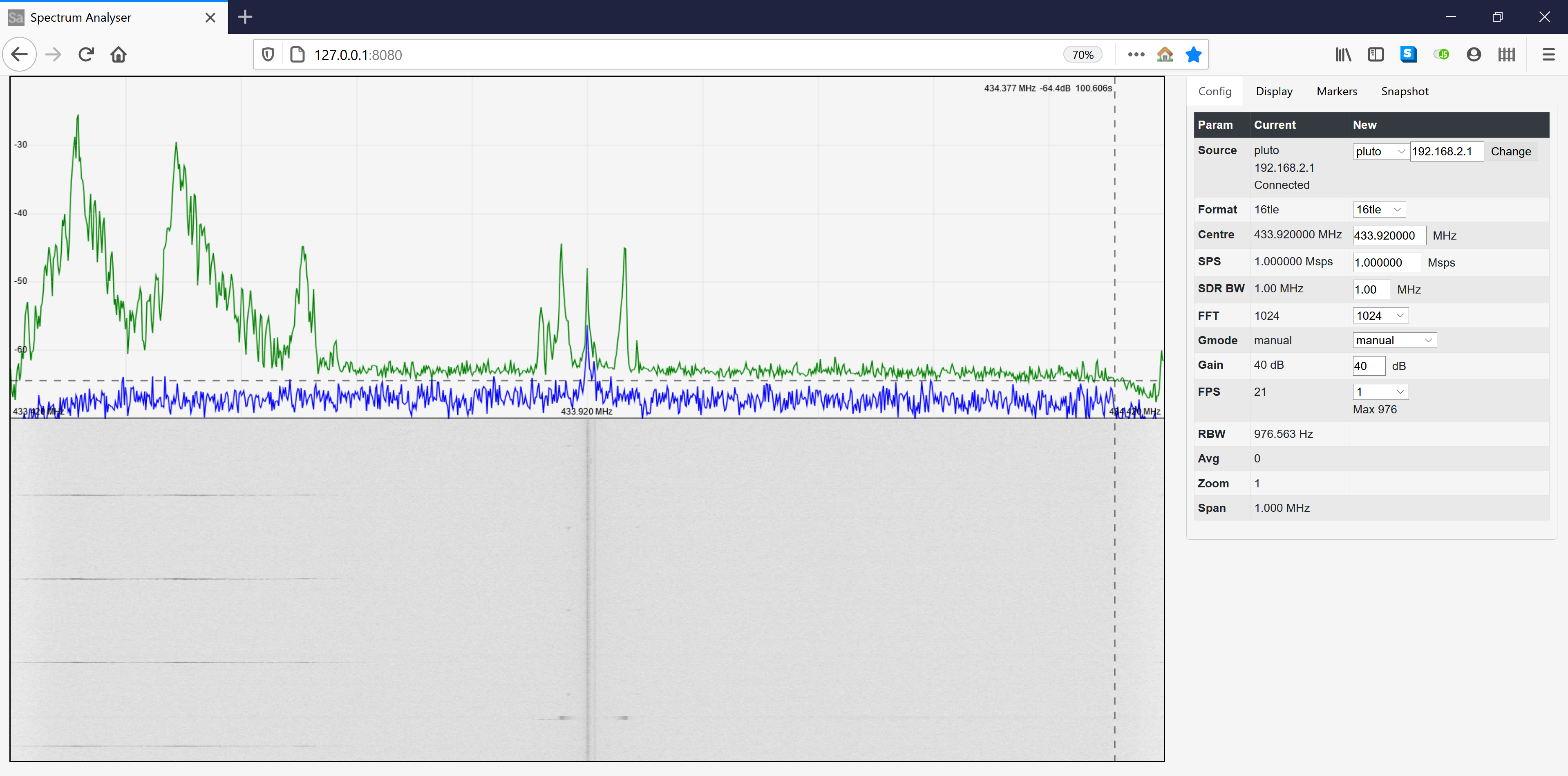Support for rtlsdr, pluto, funcube, sdrplay (soapy), audio, socket, file.
- Python processing.
- Web javascript UI.
- Spectrums are done at the sample rate.
- Useful for detecting short bursting signals.
- Plugin architecture for sources and analysis of spectrums.
- Snapshot file upon an event, currently a manual trigger.
- Has a web based UI that can be used to take measurements on the spectrum.
- Processing runs with no web client attached.
This was an exercise in writing some python which expanded into providing a web based UI. The fft computations are done by libraries in Python, so not the fastest.
If you have some sort of sdr working with other tools then after installing the required python dependencies it should just work.
Performance depends on your machine and how the supporting fft libraries were compiled. I have certainly kept up with streams of data at over 3Msps.
- audio - Useful for testing
- file - wav and raw binary supported, all files must be in the snapshot directory
- pluto (IP) - Analog devices pluto SDR, 70MHz to 6GHz with wide open front end
- rtlsdr - USB source
- rtltcp - rtl over tcp
- socket - A stream of IQ samples
- funcube - Pro and pro+ as audio devices, hid control supported in Linux only
- soapy - Support for sdrplay under Linux
- 8bit offset binary
- 8bit 2's complement
- 16bit 2's complement little endian (x86)
- 16bit 2's complement big endian
- 32bit ieee float little endian
- 32bit ieee float big endian
- If the programme exceptions immediately, check the dependencies.
- funcube will exception under windows when closed, which we do when changing the source
Should be similar to the linux install, but
- No support for hid control of funcube, we can stream samples but not control the device.
- No support for sdrplay, as we don't have SoapySDR support - don't know how to install on windows.
cd ~
git clone https://github.com/naj1024/pyspectrum.git
Edit requirements.txt for required input sources.
vi ./pyspectrum/src/requirements.txt
I'm using pipenv for a virtual environment.
pipenv shell
pip install -r ./pyspectrum/src/requirements.txt
Run, then connect to localhost:8080 in a browser
python3 ./pyspectrum/src/SpectrumAnalyser.py
The easiest way to get SoapySDR support is to install it from your distributions repository
apt install python3-soapysdr
dpkg -L dpkg -L python3-soapysdr
then copy to your virtual environment, say it is called sid-xxxx
cp /usr/lib/python3/dist-packages/SoapySDR.py ~/.local/share/virtualenvs/sid-xxxx/lib/python3.9/site-packages/
cp /usr/lib/python3/dist-packages/_SoapySDR.cpython-39-x86_64-linux-gnu.so ~/.local/share/virtualenvs/sid-xxxx/lib/python3.9/site-packages/
- hackrf input would be nice to try, don't have one :(
- Detect and record automatically
Windows: audio, file, pluto, rtlsdr, rtltcp, socket, funcube
Linux : audio, file, pluto, rtlsdr, rtltcp, socket, funcube
soapy(audio, rtlsdr, sdrplay)
On windows make sure you have the correct rlibrtlsdr.dll for your python 32bit/64bit
Some examples for running from command line
python ./SpectrumAnalyser.py - Then goto http://127.0.0.1:8080 and configure the source
python ./SpectrumAnalyser.py -h - help
python ./SpectrumAnalyser.py -i? - list input sources that are available
Some default input selections, you normally select through web interface:
python ./SpectrumAnalyser.py -ipluto:192.168.2.1 -c433.92e6 -s600e3 - pluto at 433MHz and 600ksps
python ./SpectrumAnalyser.py -ipluto:192.168.2.1 -c433.92e6 -s1e6
--plugin analysis:peak:threshold:12
--plugin report:mqtt:broker:192.168.0.101 - detect and log signals
python ./SpectrumAnalyser.py -ifile:test.wav -c433.92e6 - a test wav file
python ./SpectrumAnalyser.py -iaudio:1 -s48e3 -iaudio:1 - audio input
python ./SpectrumAnalyser.py -irtlsdr:kk -c433.92e6 -s1e6 - rtlsdr
SOAPY:
python ./src/SpectrumAnalyser.py -isoapy:audio -s48000 -c0 - soapy input
python ./src/SpectrumAnalyser.py -isoapy:sdrplay -s2e6 c433.92e6
The following python modules should be installed. Optional ones provide specific capabilities.
Required:
numpy
websockets
matplotlib
Testing:
pytest
Optional:
scipy - another FFT library
pyfftw - another FFT library, faster above 8k size (for me)
pyadi-iio - pluto device
iio - pluto device
pyrtlsdr - rtlsdr devices
sounddevice - audio and funcube devices
soapysdr - soapy support
paho-mqtt - mqtt plugin (client)
hid - funcube control through usb hid, linux only?
We can add support for pluto frequency correction in ppm by adding the following to the file ad936x.py when pyadi-iio is installed. You should find the ad936x.py file under the adi directory in the site packages traversed by your environment. Insert the lines in the ad9364 class definitions.
@property
def xo_correction(self):
return self._get_iio_dev_attr("xo_correction")
@xo_correction.setter
def xo_correction(self, value):
self._set_iio_dev_attr_str("xo_correction", value)
